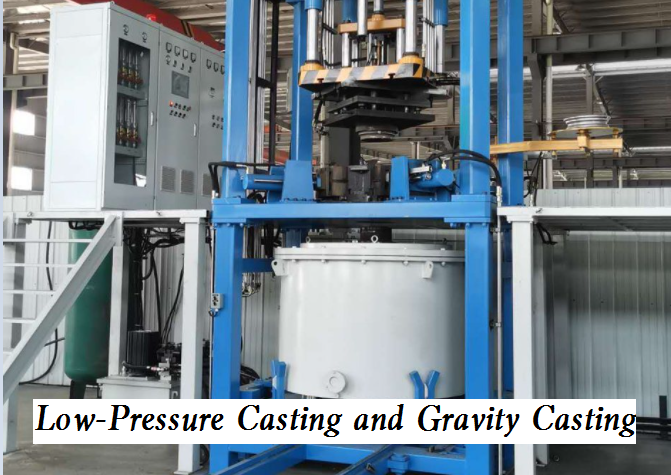Casting can be divided into gravity casting and pressure (die) casting according to the pouring form of liquid metal. This article focuses on low-pressure casting and gravity casting.

What is Low-Pressure Casting?
Low pressure casting refers to a casting method in which the mold is generally placed above a sealed crucible, and compressed air is introduced into the crucible to create a low pressure (0.06-0.15MPa) on the surface of the molten metal so that the liquid metal rises from the riser pipe to fill the mold and control solidification. Use dry and clean compressed air to press the aluminum liquid in the holding furnace up to the mold cavity of the casting machine steadily from bottom to top through the riser and gating system until the pressure is released after the casting solidifies. This process fills and solidifies under pressure, so it has good filling properties, less shrinkage porosity, and high compactness. This casting method can easily produce large and complicated castings with thin walls, without a riser, and the metal yield can reach 95%. No pollution, easy automation. However, the equipment cost is high and the production efficiency is low. It is generally used for casting nonferrous alloys. Low pressure casting can adopt sand mold, metal mold, graphite mold, etc. The mold filling process is not only different from gravity castings such as metal mold casting and sand mold casting but also different from die casting with high pressure and high-speed mold filling Low pressure casting is the earliest counter gravity casting technology.
What is Gravity Casting?
Gravity casting refers to the process in which molten metal is injected into the mold under the action of the earth’s gravity, also known as pouring. The generalized gravity casting includes sand mold casting, metal mold casting, investment casting, lost foam casting, mud mold casting, etc. In a narrow sense, gravity casting mainly refers to metal mold casting. The advantages of gravity casting include less internal porosity of castings, heat treatment, low cost of molds, the long service life of molds, simple process, is suitable for large batch operation, low fluidity of special aluminum alloy, and wide application range of materials.
Similarities and Differences Between Low-Pressure Casting and Gravity Casting
1) Mold selection: both are divided into a metal mold and non-metal mold (such as sand mold). The purchase cost of metal mold is relatively high, while the purchase cost of the wood mold is low. However, if it is not used for a long time or needs mass production, a certain maintenance cost will occur.
2) Production efficiency: metal mold low-pressure casting is easy to realize automatic production at a high rate; The mold shape and internal core box made of resin sand can only be used once, so the production efficiency is low.
3) Material utilization rate: low-pressure casting is suitable for producing thin-walled castings, and the riser occupies few materials; Gravity casting is not suitable for producing thin-walled castings, and a riser is required. Risers are supplementary parts attached to the top or side of castings to avoid defects. The gate is the head of the part and the riser is the tail of the part to observe whether the cavity is filled with saturation. Both need to be removed.
4) Casting material: gravity casting is made of ferrous metal and nonferrous metal. Low pressure casting is mainly used for nonferrous metal casting. Alloy materials are expensive. Low pressure casting can reduce riser loss.
5) Working environment: Low pressure casting is mostly a mechanized operation, and the labor environment of workers is good, while the labor environment of workers in gravity casting is poor, especially in the pouring operation.

